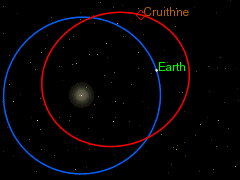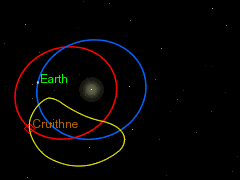(3753) Cruithne
|
Asteroid (3753) Cruithne |
|
|---|---|
| Properties of the orbit ( animation ) | |
| Orbit type | Aten type |
| Major semi-axis | 0.998 AU |
| eccentricity | 0.515 |
| Perihelion - aphelion | 0.484 AU - 1.511 AU |
| Inclination of the orbit plane | 19.811 ° |
| Sidereal period | 364 d |
| Physical Properties | |
| Medium diameter | approx. (2.1 ± 0.2) km |
| Albedo | 0.34 ± 0.10 |
| Rotation period | 27.4 h |
| Absolute brightness | 15.6 mag |
| Spectral class | SMASSII: Q |
| history | |
| Explorer | J. Duncan Waldron |
| Date of discovery | October 10, 1986 |
| Another name | 1986 TO, 1983 UH |
| Source: Unless otherwise stated, the data comes from JPL Small-Body Database Browser . The affiliation to an asteroid family is automatically determined from the AstDyS-2 database . Please also note the note on asteroid items. | |
(3753) Cruithne is a near-Earth asteroid of the Aten-type and a co-orbital object of the Earth.
discovery
The asteroid was discovered on October 10, 1986 at the Siding Spring Observatory . It was initially given the provisional designation 1986 TO . During the subsequent calculation of its orbit, it was recognized that it is identical to the 1983 UH object , which was discovered in 1983 at the European Southern Observatory (ESO) in Chile . He was later given the name Cruithne ( pronunciation : [ ˈkɾˠɪhn̠ʲə ] in modern Irish ). This goes back to Cruthin ( pronunciation : [ ˈkɾˠʊθʲɪn̠ʲ ]), an old Irish name used in the early Middle Ages before 773 for the Picts in Scotland ( Annals of Ulster ), possibly inspired by ancient ideas of eponymous ancestors ( Pictish Chronicles ).
Orbit
(3753) Cruithne orbits the Sun in a highly eccentric Aten-type orbit . Another peculiarity is that (3753) Cruithne was the first discovered asteroid, whose mean period around the sun corresponds almost exactly to a sidereal year . This means that it interacts with the earth , since such an orbit is only stable under certain conditions. So far only a few such asteroids interacting in 1: 1 orbital resonance with the earth are known. Asteroids that are in 1: 1 resonance with a planet are also called co-ordinate objects because they follow the planet's orbit. The best-known co-ordinate asteroids are the so-called Trojans , which are located in Lagrangian points L 4 and L 5 of the respective planet. However, Cruithne is not a Trojan. In 1997, scientists from York University ( Canada ) and the University of Turku (Finland) examined its orbit more closely and found a complex horseshoe orbit that interacted with the Earth . In the meantime, however, it is no longer counted among the real horseshoe orbit companions of the earth, mainly due to its strongly eccentric orbit, but counts the asteroid 2002 AA 29 as the first known real horseshoe companion on earth.
Cruithne moves at a distance of 0.48 AE ( Perihel ) to 1.51 AE Aphel to the sun . Its eccentric orbit reaches almost as far as the orbit of Mercury near the sun and crosses the orbit of Mars in the outer areas .
Its orbit is clearly inclined towards the ecliptic ( orbit plane of the earth) at 19.8 ° . It is therefore mostly well outside the orbital plane of the planets.
Cruithne is sometimes referred to as Earth's second moon , but this is incorrect. The asteroid does not run around the earth, but moves on an earth- co-orbital orbit around the sun, whereby its orbital period corresponds almost to a sidereal year and is therefore almost the same as that of the earth.
The actual duration of the Cruithne orbit is only on average one year, the orbit is a little shorter than a year for about 190 years and a little longer in the following 190 years.
In the illustration in which the earth-sun connection is chosen as the fixed axis, the orbit of the asteroid has a complex horseshoe shape, i. H. the asteroid slowly approaches the earth “from the front” (from the direction of movement of the orbit), disappears again in the same direction, reappears 190 years later “from the back” and moves away again after another 190 years “from the front” again " get. A complete cycle takes about 385 years. Cruithne was discovered in the current phase of such proximity to the earth and is now moving away from the earth again. Because of the subtle interaction with the earth, there is no danger of it colliding with it. Because of this, it cannot get closer to the earth in its orbit than up to 15 million km - that is about 40 times the distance between the earth and the moon. Because of its small size, it is not visible to the naked eye even at the time of closest approach.
Such orbit is considered due to its horseshoe shape in this particular frame of reference also horseshoe orbit . However, the orbit of Cruithne is even more complex due to its great eccentricity and its rather high inclination, which is why it does not follow a real horseshoe orbit around the earth. Orbit simulations show that it has been in this orbit for some time. However, according to computer simulations, its orbit is not stable in the long term. Presumably, Cruithne will only have this relationship with the earth's orbit for a few millennia and then take another orbit.
Similar asteroids
Several asteroids are now known to have such a relationship to the Earth's orbit: (85770) 1998 UP1 , (54509) YORP and 2002 AA29 . The latter has an almost circular orbit near the earth and is considered to be the first true co-ordinate companion of the earth on a horseshoe orbit.
literature
- Nature : Volume 387, pages 685-686 (1997): An asteroidal companion to the Earth : Wiegert, P .; Innanen, K .; Mikkola, S .: Preprint of the article available on Prof. P. Wiegert's homepage (in English): http://www.astro.uwo.ca/~wiegert/3753/preprint.html
- The Astronomical Journal : Volume 115, Pages 2604-2613 (1998): The orbital evolution of near-Earth Asteroid 3753 : Wiegert, P., Innanen, K. and Mikkola, S .: Article available online on the Astronomical Journal server ( in English): ( PDF; 4.58 MB )
- Icarus : Volume 147, Issue 2, Pages 487–497: 10/2000: The Near-Earth Objects Follow-up Program: III. 32 Lightcurves for 12 Objects from 1992 and 1995 : A. Erikson, S. Mottola, JSV Lagerros, M. Lindgren, J. Piironen, T. Oja, G. Hahn, C. -I. Lagerkvist, AW Harris, A. Nathues and G. Neukum: Abstract and article (in PDF format) available online on the Icarus server (in English): doi: 10.1006 / icar.2000.6457
- Icarus : Volume 171, Issue 1, Pages 102-109: 09/2004: Transient co-orbital asteroids : Brasser, R .; Innanen, KA; Connors, M .; Veillet, C .; Wiegert, P .; Mikkola, Seppo; Chodas, PW: Article available online on the Icarus server (in English): doi: 10.1016 / j.icarus.2004.04.019
Web links
- Analysis and graphics of the orbit (3753) Cruithne (English)
- Physical data of (3753) Cruithne from the EARN database (English)
- Orbit data from (3753) Cruithne from the NEODyS database (English)

